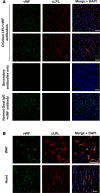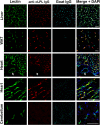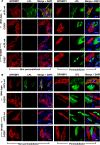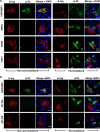Lipoprotein lipase reaches the capillary lumen in chickens despite an apparent absence of GPIHBP1
- PMID: 29046479
- PMCID: PMC5846916
- DOI: 10.1172/jci.insight.96783
Lipoprotein lipase reaches the capillary lumen in chickens despite an apparent absence of GPIHBP1
Abstract
In mammals, GPIHBP1 is absolutely essential for transporting lipoprotein lipase (LPL) to the lumen of capillaries, where it hydrolyzes the triglycerides in triglyceride-rich lipoproteins. In all lower vertebrate species (e.g., birds, amphibians, reptiles, fish), a gene for LPL can be found easily, but a gene for GPIHBP1 has never been found. The obvious question is whether the LPL in lower vertebrates is able to reach the capillary lumen. Using purified antibodies against chicken LPL, we showed that LPL is present on capillary endothelial cells of chicken heart and adipose tissue, colocalizing with von Willebrand factor. When the antibodies against chicken LPL were injected intravenously into chickens, they bound to LPL on the luminal surface of capillaries in heart and adipose tissue. LPL was released rapidly from chicken hearts with an infusion of heparin, consistent with LPL being located inside blood vessels. Remarkably, chicken LPL bound in a specific fashion to mammalian GPIHBP1. However, we could not identify a gene for GPIHBP1 in the chicken genome, nor could we identify a transcript for GPIHBP1 in a large chicken RNA-seq data set. We conclude that LPL reaches the capillary lumen in chickens - as it does in mammals - despite an apparent absence of GPIHBP1.
Conflict of interest statement
Figures









Similar articles
-
GPIHBP1 is responsible for the entry of lipoprotein lipase into capillaries.Cell Metab. 2010 Jul 7;12(1):42-52. doi: 10.1016/j.cmet.2010.04.016. Cell Metab. 2010. PMID: 20620994 Free PMC article.
-
Distinct strategies for intravascular triglyceride metabolism in hearts of mammals and lower vertebrate species.JCI Insight. 2024 Sep 17;9(20):e184940. doi: 10.1172/jci.insight.184940. JCI Insight. 2024. PMID: 39435661 Free PMC article.
-
The GPIHBP1-LPL complex is responsible for the margination of triglyceride-rich lipoproteins in capillaries.Cell Metab. 2014 May 6;19(5):849-60. doi: 10.1016/j.cmet.2014.01.017. Epub 2014 Apr 10. Cell Metab. 2014. PMID: 24726386 Free PMC article.
-
Glycosylphosphatidylinositol-anchored high-density lipoprotein-binding protein 1 and the intravascular processing of triglyceride-rich lipoproteins.J Intern Med. 2012 Dec;272(6):528-40. doi: 10.1111/joim.12003. Epub 2012 Nov 1. J Intern Med. 2012. PMID: 23020258 Free PMC article. Review.
-
GPIHBP1 and Plasma Triglyceride Metabolism.Trends Endocrinol Metab. 2016 Jul;27(7):455-469. doi: 10.1016/j.tem.2016.04.013. Epub 2016 May 14. Trends Endocrinol Metab. 2016. PMID: 27185325 Free PMC article. Review.
Cited by
-
A protein of capillary endothelial cells, GPIHBP1, is crucial for plasma triglyceride metabolism.Proc Natl Acad Sci U S A. 2022 Sep 6;119(36):e2211136119. doi: 10.1073/pnas.2211136119. Epub 2022 Aug 29. Proc Natl Acad Sci U S A. 2022. PMID: 36037340 Free PMC article.
-
GPIHBP1 and ANGPTL4 Utilize Protein Disorder to Orchestrate Order in Plasma Triglyceride Metabolism and Regulate Compartmentalization of LPL Activity.Front Cell Dev Biol. 2021 Jul 15;9:702508. doi: 10.3389/fcell.2021.702508. eCollection 2021. Front Cell Dev Biol. 2021. PMID: 34336854 Free PMC article. Review.
-
An upstream enhancer regulates Gpihbp1 expression in a tissue-specific manner.J Lipid Res. 2019 Apr;60(4):869-879. doi: 10.1194/jlr.M091322. Epub 2018 Dec 31. J Lipid Res. 2019. PMID: 30598475 Free PMC article.
-
Evolution and Medical Significance of LU Domain-Containing Proteins.Int J Mol Sci. 2019 Jun 5;20(11):2760. doi: 10.3390/ijms20112760. Int J Mol Sci. 2019. PMID: 31195646 Free PMC article. Review.
-
Ligand-based in silico identification and biological evaluation of potential inhibitors of nicotinamide N-methyltransferase.Mol Divers. 2023 Jun;27(3):1255-1269. doi: 10.1007/s11030-022-10485-7. Epub 2022 Jul 6. Mol Divers. 2023. PMID: 35793051
References
Publication types
MeSH terms
Substances
Grants and funding
LinkOut - more resources
Full Text Sources
Other Literature Sources

